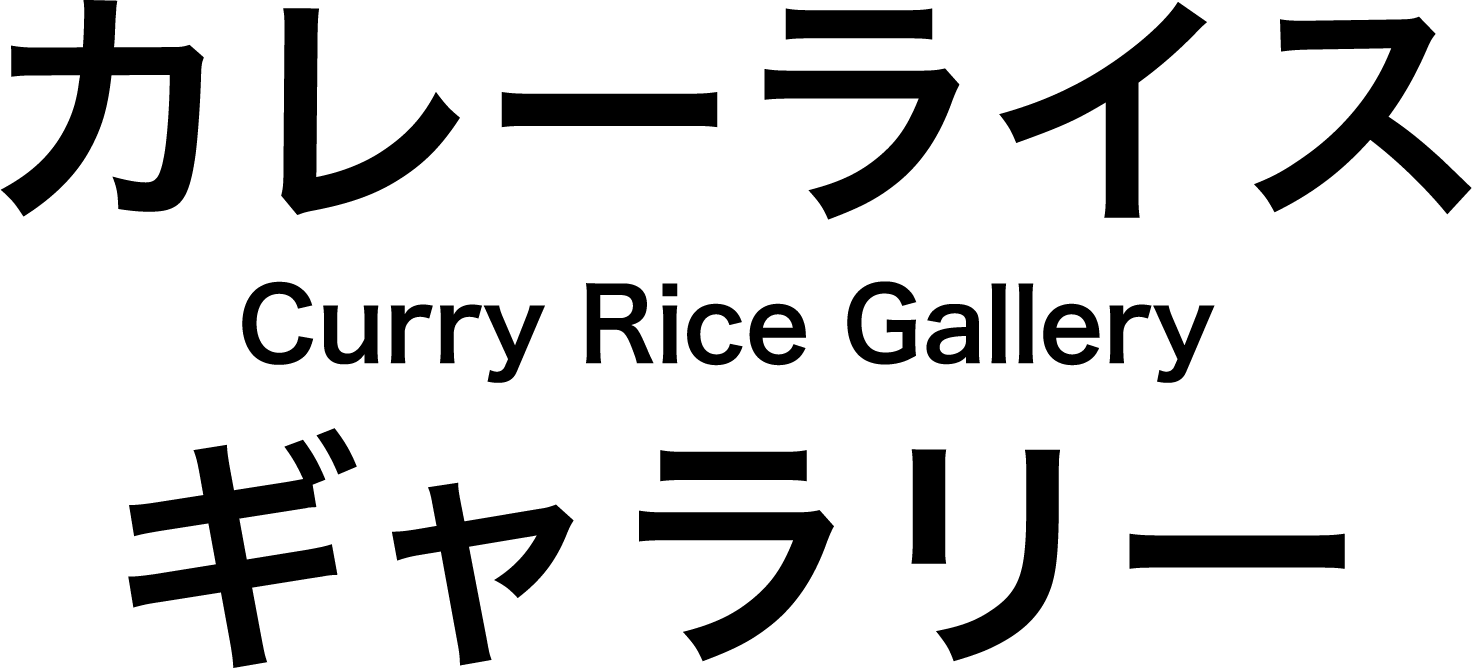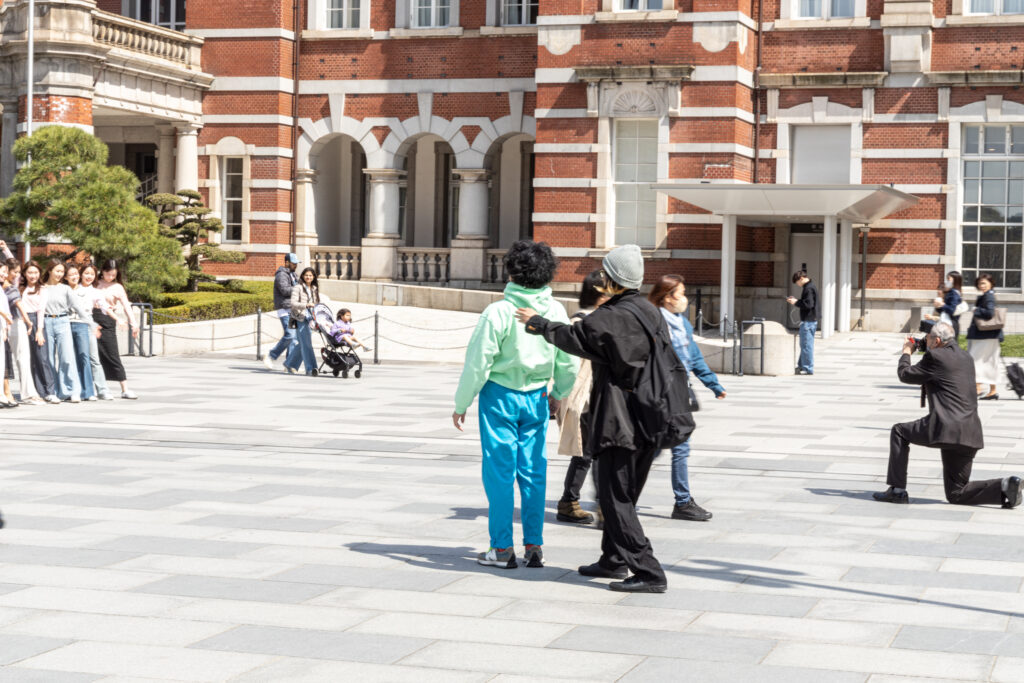
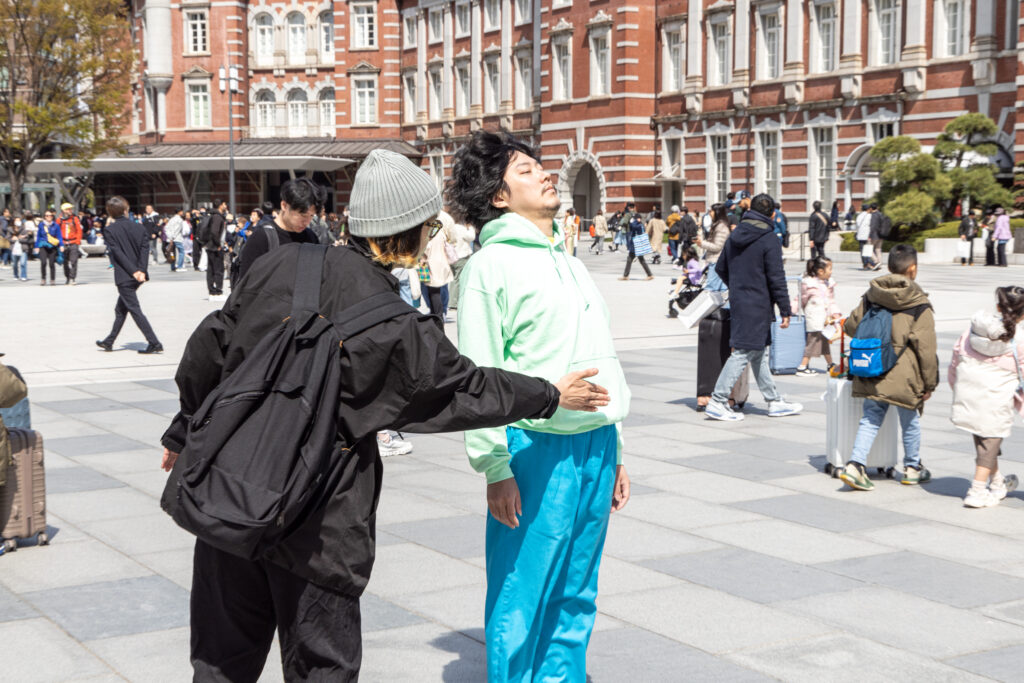
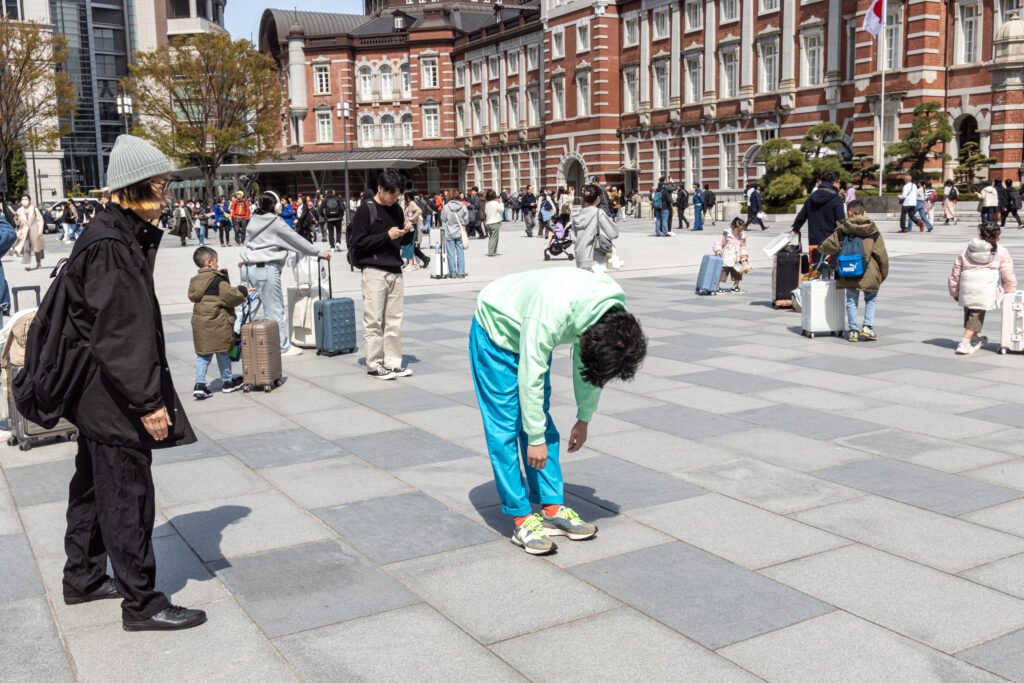
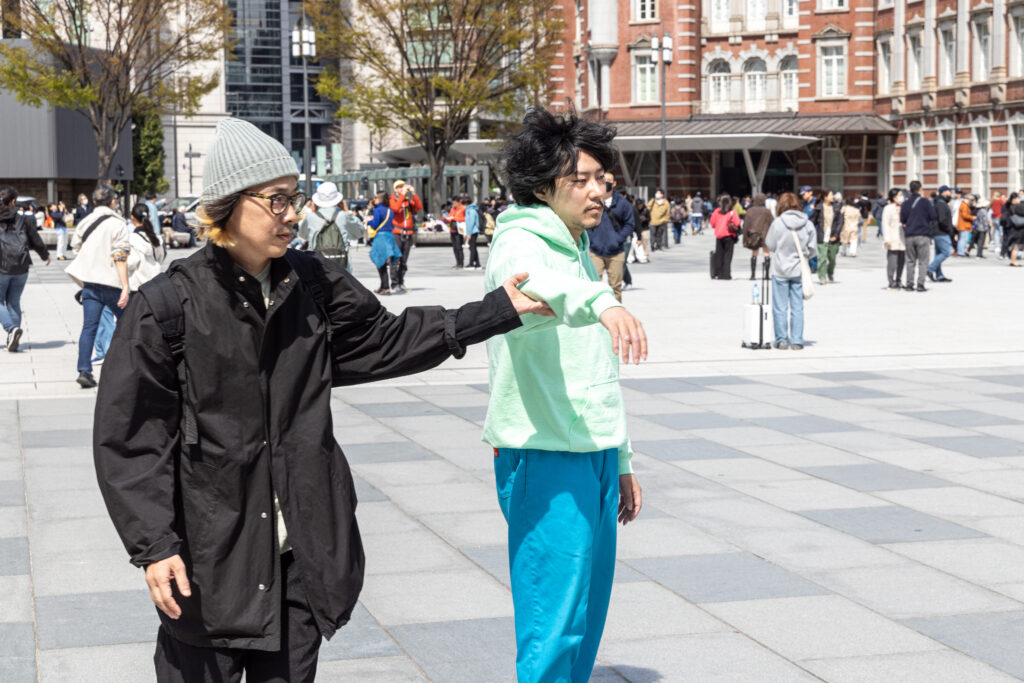
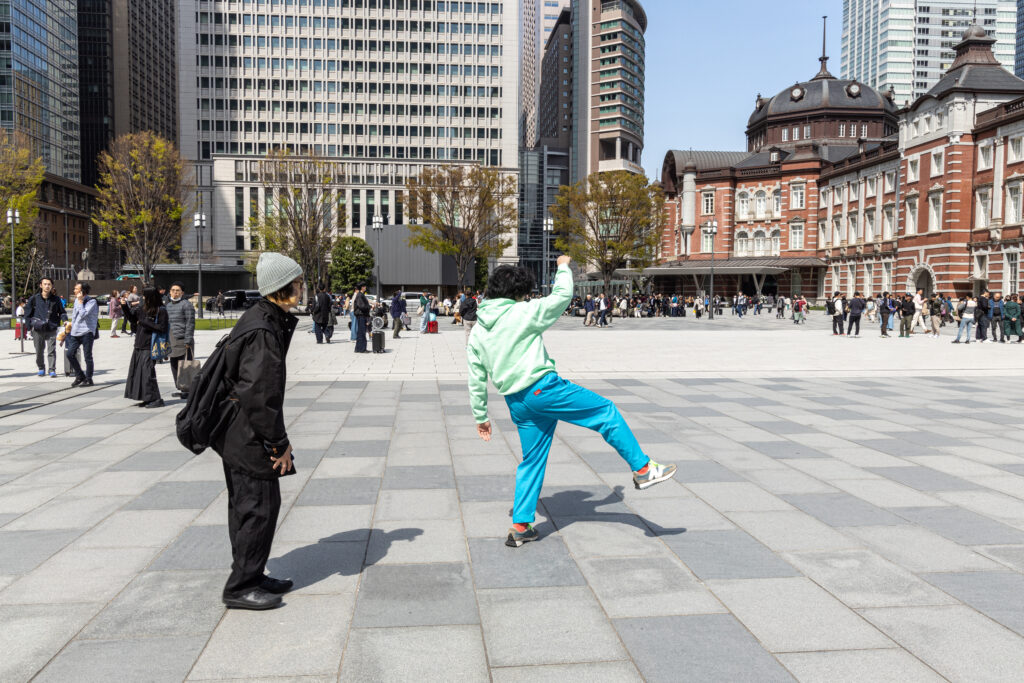
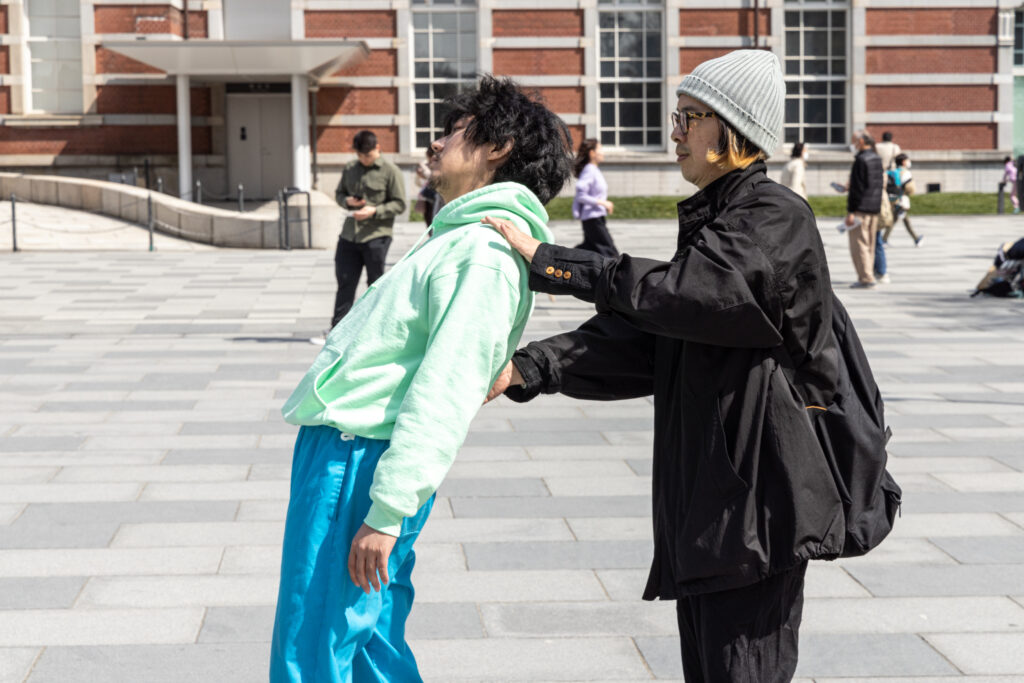
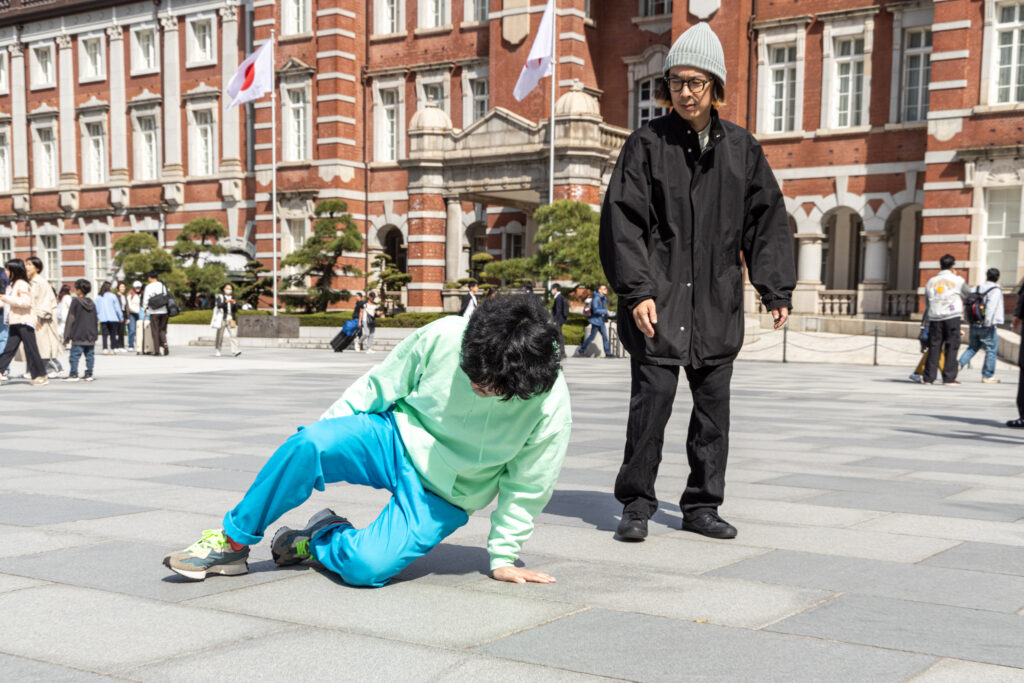
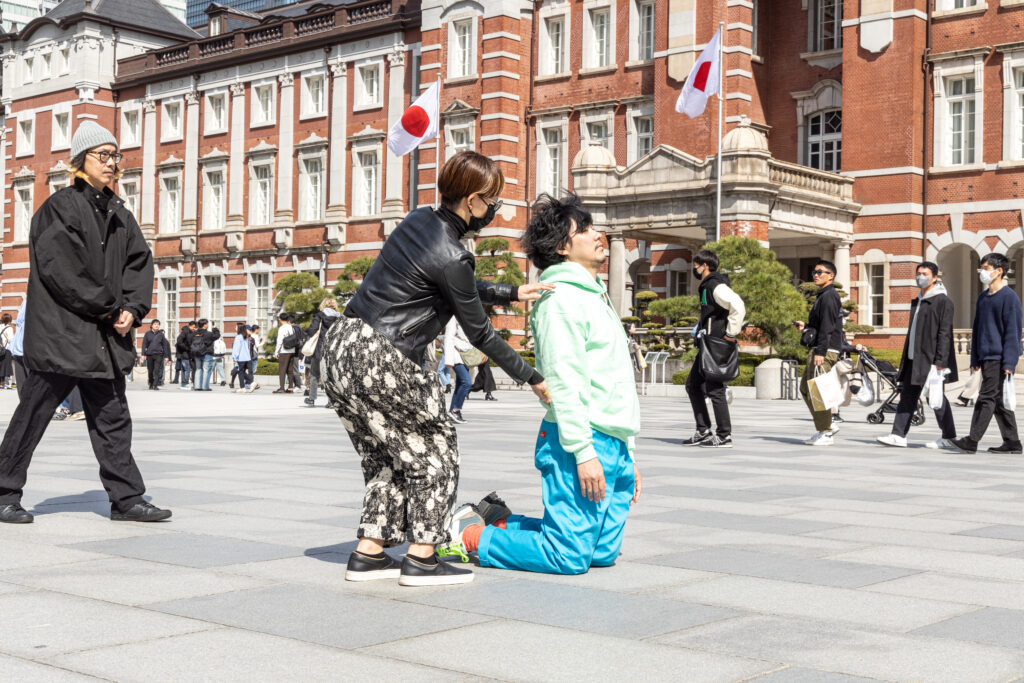
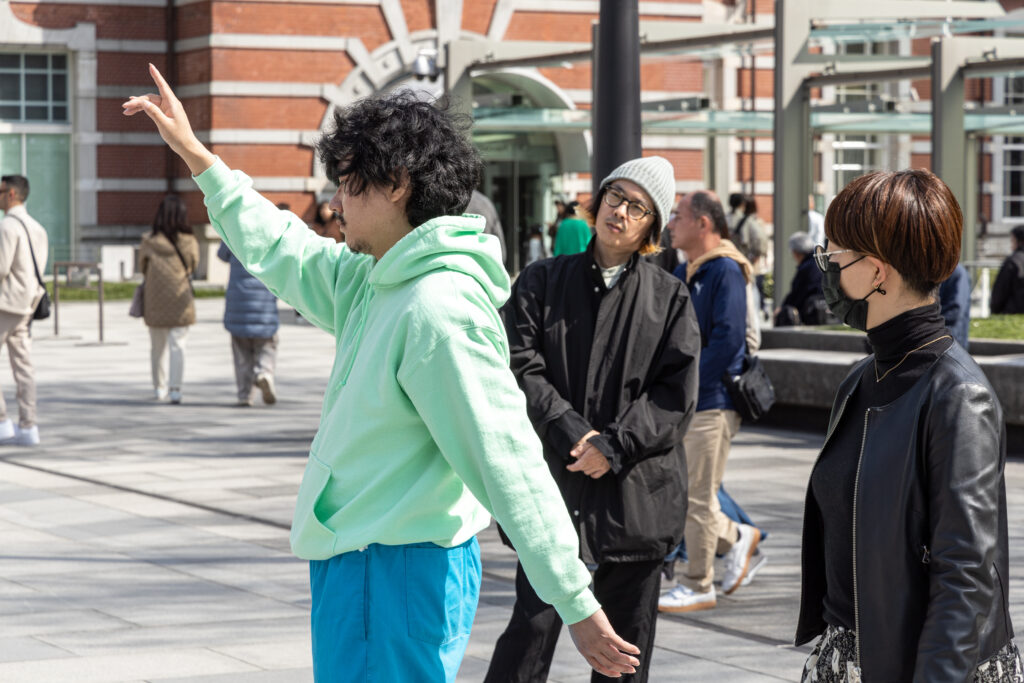
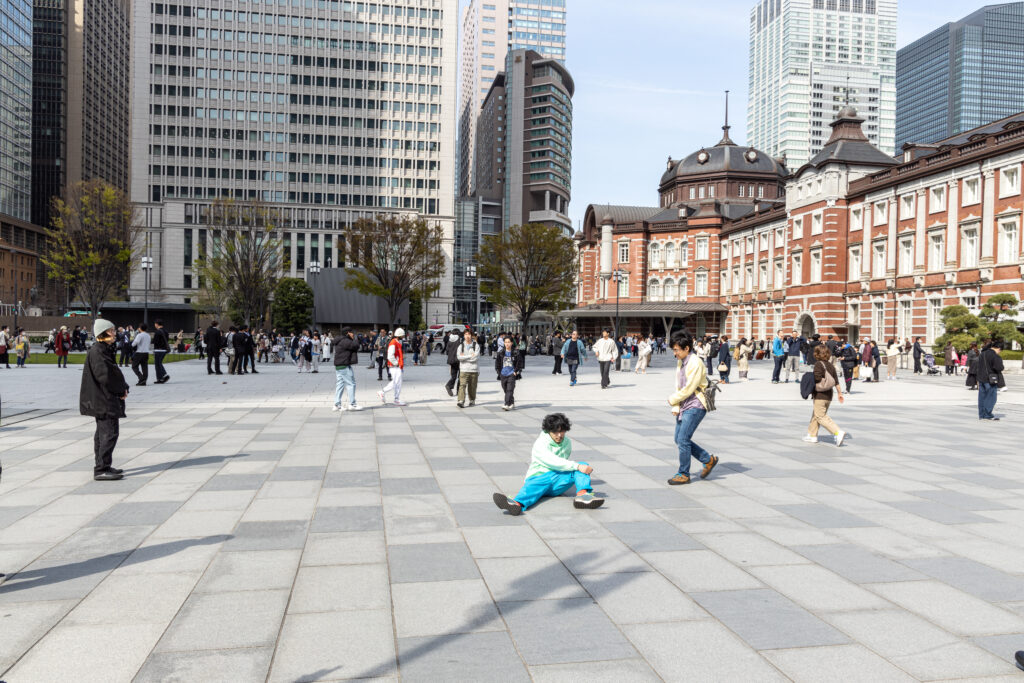
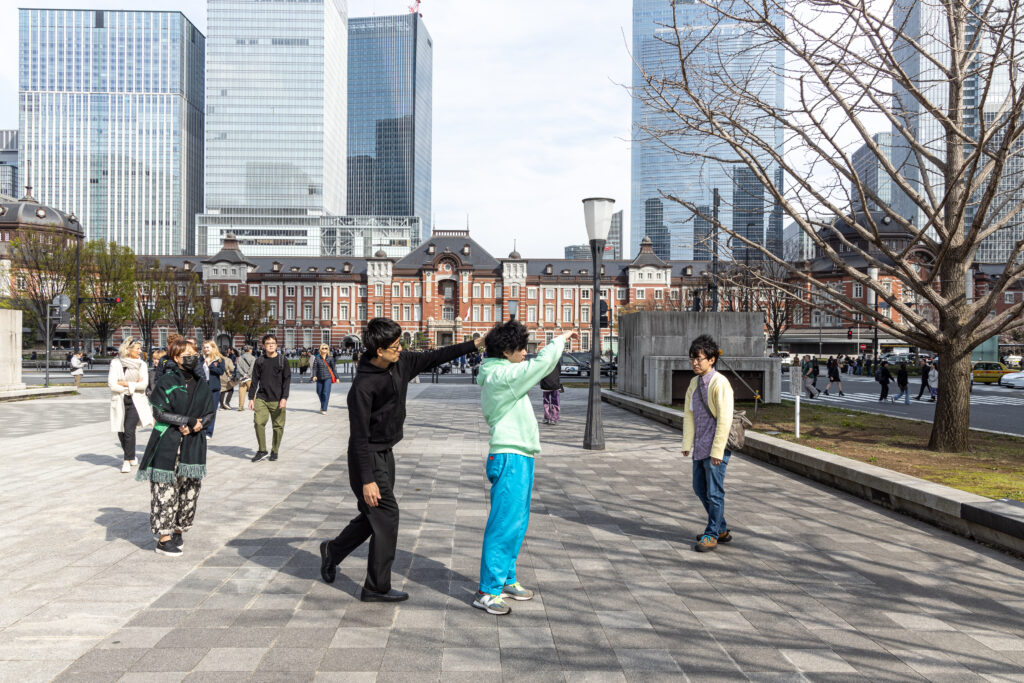
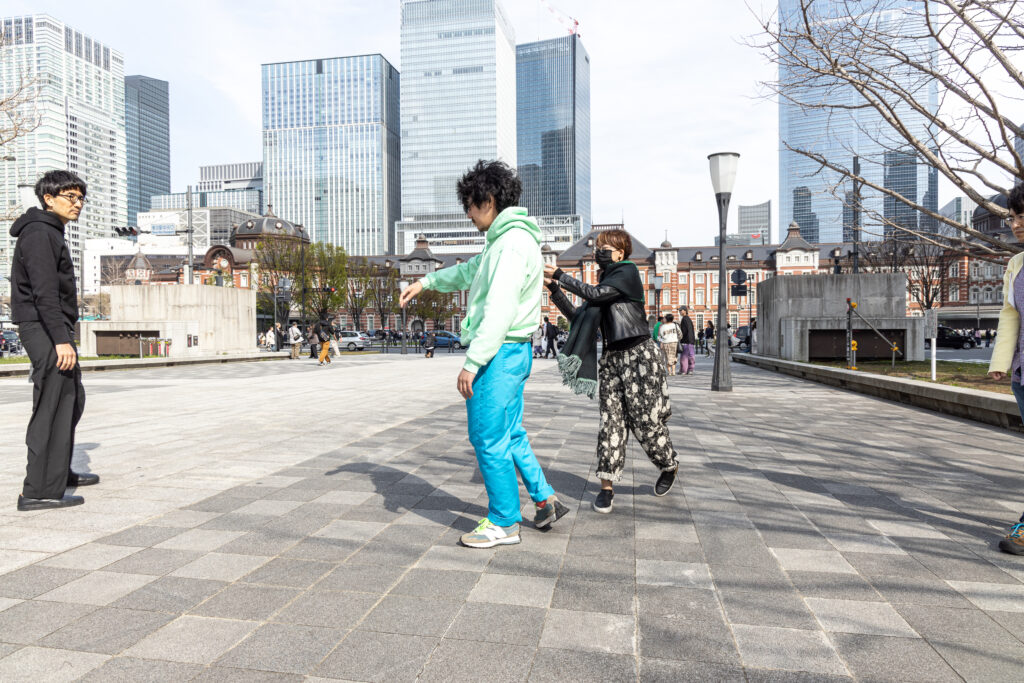
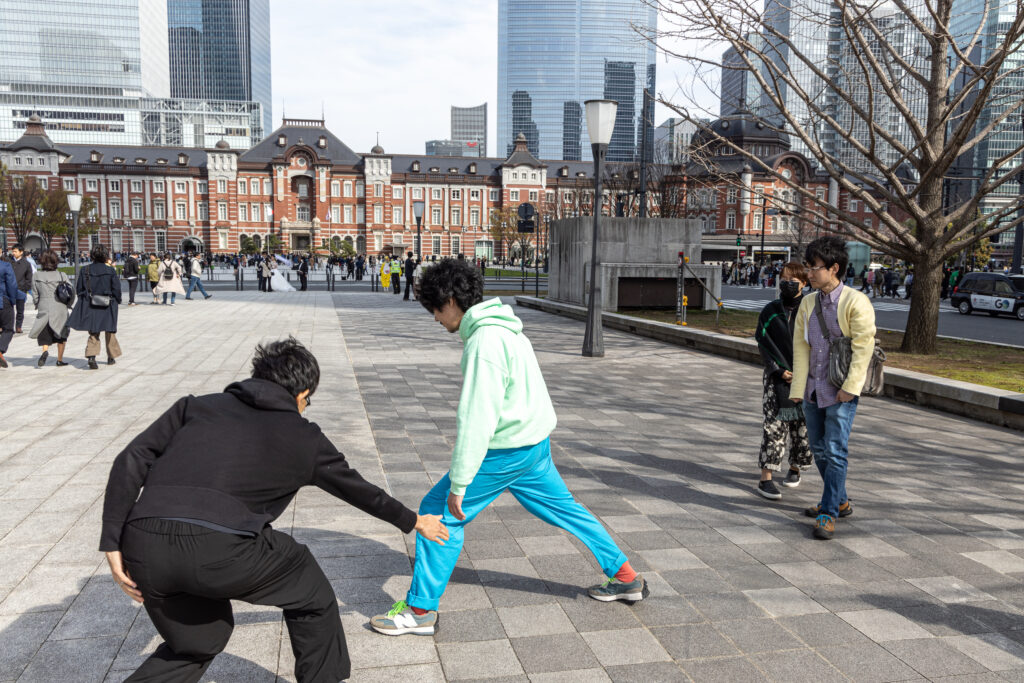
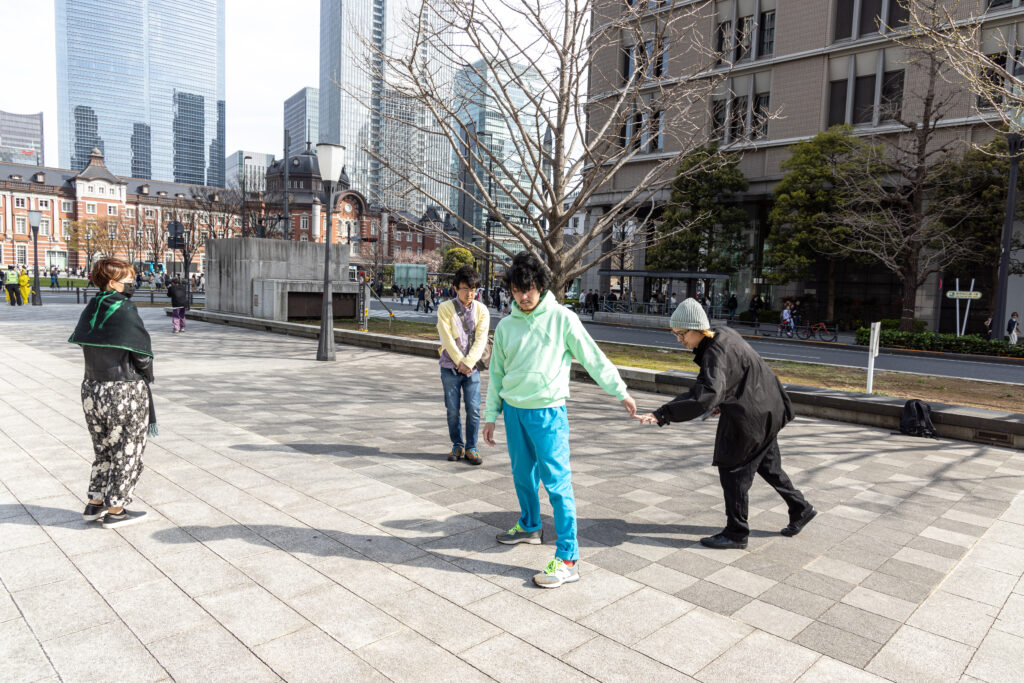
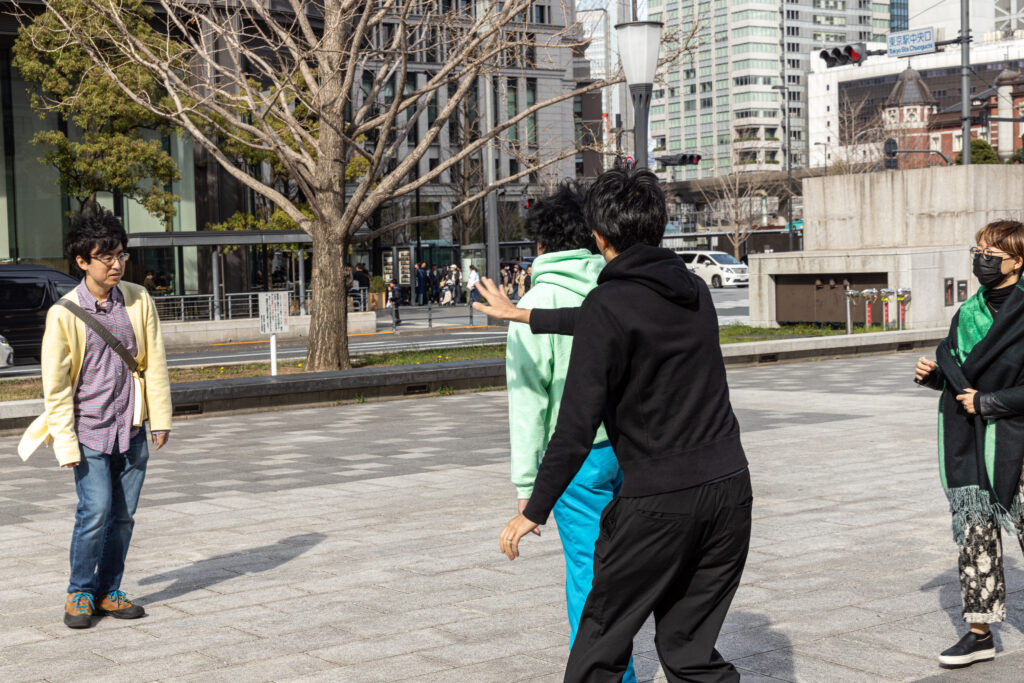
photo and video: 松尾宇人 Ujin Matsuo
ー
ダンサーである倉石幸彦は、2025年3月に、アーティストインレジデンスPARADISE AIRに滞在した。そこで同じ期間に滞在していたウクライナを拠点とするダンサーのValeriya Koptsevaの成果発表であるワークショップ「フリームーブメント・プラクティス」に影響を受けた。そのワークショップで行われていた、その場にいた参加者が自由に対象となる人の身体の一部を触れることによって、自分主体的に動くのではなく、半ば受動的に動かされることによってムーブメントが行われるという、倉石にとって新鮮な体験を体験したのだった。
そこで得た体験をもとに、観客が自由に倉石の身体をコンタクトすることによって、倉石のムーブメントをコントロールすることができるという、参加型のインプロヴィゼーショナルな形式を考え、今回のパフォーマンスとして企画することになった。
今回のパフォーマンスでは、そのよう受動的に倉石が観客によって動かされる、そして、観客はまた倉石の動きによって、次の動きをコントロールするようにコントロールされる、というインタラクティブな相互関係が生まれるパフォーマンス空間をつくりげた。
ー
「Tokyo Free Movement 2025」倉石幸彦
会場:Curry Rice Gallery (東京駅丸の内駅前広場)
日時:2025年4月5日(土)13:00〜
ー
倉石幸彦 Yukihiko Kuraishi
ダンサー。ポストモダンダンスの考え方に影響を受けながら、路上や公園、公共空間など様々な場所で即興でダンスを踊り、主に写真や映像によって記録している。主なパフォーマンスに、2024年「Yukki」callbox(東京)、「うあーパフォーマンスフェスティバル vol.5」白河市街地(福島)、「トノサマバッタのハッピーバースデーパーティーについて行った!」Maebashi Works(群馬)、「マジック・マジック・サンシャイン?どんなスニーカーも空を飛ぶ」O CHA NO MA(福島)、「一那由多のちょんまげスプーン」千秋公園大手門の堀遊歩道(秋田)、「しまうまのお腹でそのUFOは休憩をする」門司港駅周辺(福岡)、2025年「Tokyo Free Movement 2025」Curry Rice Gallery (東京駅丸の内駅前広場)(東京)など。
ー
協力: Valeriya Koptseva @lerakoptseva
ー
レビュー『マジック・メモ ―― 倉石幸彦さん《Tokyo Free Movement 2025》に寄せて』平岡希望
「東京駅」と刻まれた碑の前に立ち、正面玄関の「御車(みくるま)寄せ」を背に記念撮影をする人たち。彼らの視界の両サイドには、「丸の内駅前広場」から奥の「行幸通り」へと一直線に伸びる街灯があり、その間を目まぐるしく通り過ぎたり、あるいはしばし立ち止まったりする分子のごとき人々の運動が映っているだろうが、その中でも左列の街灯、手前から3本目あたりに佇むミントグリーンのパーカーが眩しいはずだ。
その人物こそ倉石幸彦さんで、赤レンガ駅舎から20メートルほど、御車寄せ向かって右脇の中央口あたりをやや反り腰気味に見る彼に、参加者のNさんが背後からスススッ…と近づく。そして倉石さんの左腕が “く” の字に上がったのは、Nさんが彼の左肘をチョンと触ったからで、数秒後に下げられたその腕をまた触ると、今度はクルッと一回転した。
倉石さんは、参加者の接触に応じて数秒間身体を動かす。Nさんは、2~3メートルほど離れた位置でそうした彼の動きを見届け、数秒ほど次の一手を考えると静々と近づいて触れ、また離れて彼を見る…という風にコンタクトを続けて(「代わりますか?」とNさんは聞いてくれたが、彼らのダンスをもうしばらく見たくて私は断った)、今度は両肩にポンと掌をのせる。その “重み” にしゃがんだ彼の左肩をNさんが再度触ると、倉石さんもまた掌をペタリと石畳につけた。腰を浮かせた正座のように折り畳まれた真っ青な両足から覗いていた紅い靴下は、彼がゴロンと仰向けになったことで鮮やかさを増す。右足が少し浮き上がっているのは左足を潜り込ませているからで、きみどり色の靴ひもの、ライトグレーのシューズの底をNさんがさらにポンッと叩くと、右に寝返った倉石さんの背中が私の方を向いた。地面に投げ出された右足は、シューズ内側の青い部分を曝け出していて、脇腹をひねり伸ばしているみたいだ、というより、このパフォーマンス自体がストレッチに近い。
「今日のパフォーマンスは、この前松戸にいた時に参加したヴァレリヤさんのワークショップに影響を受けていて、参加者同士が相手の身体を触って…」と言いながら、倉石さんが自らの右腕を左手で触って動かしてみせたのは開始およそ10分前のことだった。ヴァレリヤ・コプツェヴァ(Valeriya Koptseva)氏の「フリームーブメント・プラクティス」に触発された倉石さんが、《Tokyo Free Movement 2025》と題したパフォーマンスを行うことそのものが “相手に触れられることによって、半ば受動的に生起する踊り” めいているし、即興的なそれは一回性の本番でありつつ、外的な刺激を筋肉の伸縮に変換し、その内的な感覚を味わうとともに身体への理解を深め、数秒後の腕の一振りから、今後発表されうる作品までも含めた一連の次を “開発” するための時間でもあった。
「私は問題の最終的な状態を追求することはせずに、ある種の動きに富む可能性を表わした。ゆっくりと待つのではなく、私の思想をそれが成熟する地点まで導いていく以前に、表現しようと望んだのである。〔…〕おそらく哲学においても、絵画における次のような事態と同じことが問題となる場合があるだろう。すなわち画家の積み重ねる努力がそのエスキスの形のままで、完成したタブローよりももっと多くの重要性を孕み、もっと興味をそそるように思われる時が生じるという事態である。〔…〕ただ哲学の本性のうちには、けっして終わることがないという性質が存するのであり、精神の作業は、それが決然たる意志によってある未完了な形のまま読者に委ねられた場合、たとえ半ば失敗作であったとしても、哲学的な営為の必然的に共同的な性格によりよく応じる可能性を持つのである。そしてそういう哲学的営為にこそ、人間存在は緊密に結ばれているのだ。」(ジョルジュ・バタイユ 著,湯浅博雄 訳『宗教の理論』ちくま学芸文庫,pp.163-164)
というバタイユの「諸言」は《Tokyo Free Movement 2025》だけでなく、パフォーマンスアート全体に含まれるだろう運動性・共同性にも通じているし、そもそもこの『宗教の理論』にしても、4種の異なる資料を有する “動的” な書物で、引用した一節は第1資料のものだ(cf., 同書,pp.162-163)。本文として採用された第3資料の「諸言」(同書,pp.13-17)とは、要約してしまえば大差ないのだが語り口が違うから印象は全然違って、第1資料の方がより運動的で、散らかりが散らかりのまま保持されている。
「一つの哲学=思想(フィロゾフィー)はある一貫した総体としてあるか、さもなければ存在しないかのどちらかであると私も考えるが、それが一個人のなす事柄であって人類の行うそれではないがゆえに、それは後に続くはずのものに一種の開口部を保持しておかねばならない。つまりまず私がそうである個人が今後営む思考に対して、そして次に他の諸個人が行う思想的営為に対して開かれていなければならぬ。それは一つの作業現場以外ではありえぬものであって、一軒の家であるかのごとくみなされるとすれば空しいものとなろう。」(同書,p.164)
とバタイユは言葉を重ねるが、《Tokyo Free Movement 2025》にもまた “開口部” があって、それは言うまでもなく、参加者がいなければ踊ることのできない倉石さんの存在だった。そして彼と、参加者とが作り出す半径数メートルの “現場” において、Nさんもまた様々な作業仮説を立てては検証していたようだが、「全然予想と違いました。」とこぼしたNさんもまた、立てた仮説自体によって “開発” されていた。
例えばNさんは、倉石さんがダランと下ろした両腕を、左右の指先でシュッと撫で上げることを試みた。撫で上げられた両腕を体側で固定したまま、やや曲げた足の力で一度飛び上がった彼の動き。しかしそれが観客に半ば “予見” されていたのは、撫で上げるNさんの所作、その素早さに跳ね上がるような勢いがすでにあったからで、その時、Nさんの踵は目に見えるほど浮いてはいなかった。しかし、靴の中では上向きのベクトルが生まれていたはずで、単に物理的入力として倉石さんに触るだけなら、指先だけ、腕だけの動きで事足りる。しかし、それがおそらく間違っているのは、Nさんだけでなく、私を含めたこれからの参加者たちも常に仮説を持って事に当たっていたからで、例えば、ヴァイオリンは弓を上げても下げても音自体は “同じ” だが、力の込めやすい弓元から、重力に従って弓先へ下げていく「ダウン」と、逆に弓先から弓元へ上げていく「アップ」とでは、視覚的にも力学的にも音色はかすかに変わる。演奏者はそれを加味して運弓を決めるそうだが、参加者もまた、倉石さんをしゃがませたい時には自らの体重をのせるように、逆に立たせたりジャンプさせたい時には、自身も気持ち伸び上がるようにしていた。
アリストテレスは可能態と現実態という対概念を挙げていて、例えば種子と芽の関係がそれだが、《Tokyo Free Movement 2025》における参加者と倉石さんの二者関係はその変種といった感じだった。参加者の持つ意図・予測を “可能態” だとすれば、それは上述のように、倉石さんへコンタクトする身振りの内ですでに “実現” されていて、倉石さんは、そのかすかな発露を踊りとして “拡声” していた。構造としては、指揮者の一振りが弦楽合奏のうねりを生み出すような感じなのだが、この言い方では「楽譜」「指揮者」「奏者」という領域の明晰さが際立ってしまうので、むしろ、“未知の楽器と、それに生まれて初めて触れた人(たち)” と評した方が雰囲気としては近いだろう。
川島素晴氏の《孤島のヴァイオリン》( https://www.youtube.com/watch?v=hjgGgTVsBKQ )は、「幼少より無人島で暮らすある人物が、漂着したヴァイオリンを “演奏する” 」という設定の独奏曲なのだが、弓は無いから当然叩く。ネックを握りしめ、裏板からコンコンしている内に弦をはじくことを発見し…と進展していく “たどたどしい” それは、ヴァイオリンを奏でているというよりも、
「私は雲を見ているのではなくて、雲があることで見るという行為が可能になっている。あるいは、雲が私に “見る” をもたらしている。〔…〕私が雲を見るとき、“見る” は雲によってもたらされていて、“見る私” もまた雲によってもたらされている。私が見なくても雲はあり、私がいなくても雲はあり、そして私が見なくても “見る” はある。“私” が “雲” を “見る” という関係の中で、“私” が “雲” よりも “見る” よりも遅れて最後にやってきて最初に消えていくものではあるけれど、雲によってもたらされた “見る” をしている私はそれでもやっぱり特別な何かであり、それは “私” だから私にとって特別だということではなくて、雲や空や木が “見る” をもたらす送り先として自覚するものとして特別な何かなのではないか。」(保坂和志『カンバセイション・ピース』河出文庫,pp.388-389。文中の傍線部については引用符で示した)
「玲奈と顔を合わせると、すぐにあの話になった。特にあの話をしようという気持ちがあったわけでなく、話題が勝手にわたしたちの脳をむずっと掴んでしまったのだ。おしゃべりしていたのはわたしたちの口ではなく、話題そのものだ。」(多和田葉子『穴あきエフの初恋祭り』文春文庫,p.89)
における「私-雲-見る」や「わたし-話題-玲奈」と似た関係性で、それは國分功一郎氏が言うところの「中動態」に近いかもしれない。
《孤島のヴァイオリン》は、くびれた側板をわしづかみにしてカリンバ、もっと卑近に言えばゲームボーイのように持って弦を親指で弾き続ける(そして時折、残る指で裏板を叩く)その音がフェードアウトしていって終わるのだが、それは完了というよりは(バタイユにも通ずる) “未完了”、ある種の継続性を余韻として感じさせるし、一方で、その数瞬後には飽きてヴァイオリンを砂浜に放り出しそうな気配もあって、倉石さんもまた「休憩しましょう。」と唐突に踊りを止めた。13時32分。開始からおよそ30分が経過していた。
その少し前にはMさんとHさんも合流していて、ここまでのセッションを、
【1】デュオ(倉石さん・Nさん)
とすれば、
【2】トリオ(倉石さん・Nさん・Mさん)
【3】クインテット(倉石さん・Nさん・Mさん・Hさん・私)
の2回が、小休止を挟みつつおよそ30分ずつ行われたのだが、参加者同士もまた影響を及ぼし合っていて、まずNさんとMさんは倉石さんを挟んで向かい合った。
【3. クインテット】でも、私を含めた4人は倉石さんを交点とした2本の対角線を描いており、もちろんフォーメーションは流動的なのだが、参加者同士は一定の距離を保ち、各人と倉石さんとの距離感も【1. デュオ】の時より離れ気味だった。そうした “空間を占める感じ” が伝わったのか警備員に注意され、管轄外らしい道路向かい、行幸通りの開けた区画(ここでは12月頃、特設スケートリンクが組まれ、保護者と子どもたちがよちよちと回遊していた)に移ったのだが、《Tokyo Free Movement 2025》の会場は「東京駅丸の内駅前広場」ではなく「Curry Rice Gallery (東京駅丸の内駅前広場)」となっていた。
老松孝志氏によって2024年に設立されたCurry Rice Galleryは “場所なき” ギャラリーで、ポストカード、Google DocumentおよびDrive、Instagramのアカウントやライブ機能を展示空間に見立て、これまでも5名の個展・パフォーマンスを発表してきた(あるいは現在も展示され続けている)けれど、既存の機能やプラットフォームに “Curry Rice Gallery" の名を与える試みは、
「一人の人間を一つの名前で呼ぶことにそもそも無理がある。髪の毛はしんなりして、わたしはしんなりの品川よ、と主張する。鼻は高山、頬は丸井、唇は桃井、首は長井、それぞれが別の名前をもらいたがっている。」(『穴あきエフの初恋祭り』p.46)
の一節や、(赤毛の)アンが、「輝く湖水」「恋人の小道」「雪の女王」といった具合に、グリーンゲイブルズの景色や風物へ “よりふさわしい” 名前を贈ることで、自分にとっての特別な場所・存在にしていくこととも似ていて、それらは全て、
「とすると、固有名詞はいったいなにを綴っているというのだろうか。都市の表面を意味論的に序列化し秩序付ける星座のように配置され、年代記的な配列と歴史的な理由づけのオペレーターとなりながら、これらの語(ボレゴ通り、ボットサリス通り、ブーガンヴィル通り)は、使い古された硬貨のように、刻みこまれた価値を徐々に失っていっているけれど、もとの価値がなくなっても、なにかを意味するというその能力はなおも生き続けている。〔…〕これらの地名は、もともとその場所にまつわりついていた意味あいをうすれさせ、削りとっていっている。それらの場所は、フリーの空間、空いた空間になっているのだ。その豊かな非決定性あればこそ、こうした名の数々は、認められた意味、認められない意味、字義通りの意味の描く地理のうえに、第二の詩的な地理を描きだすはたらきをしている。〔…〕すでに固有名詞にもこうした三つのはたらきがあるのがわかる。まず第一に、この象徴機構は、場所になにかの言葉をまとわせて、その場所を住めるもの、信じられるものにする(もはや分類する権力ではなくなって、なにか別のものを『許す』権能になる)。〔…〕こうした権能をもとに、このディスクールを『ローカルな権威』とよぶことにしよう。それは、もろもろの場所に意味をいっぱい詰めこんで、場所を意味に還元し、あげくにシステムを『息のできない』ものにしてしまう、そうしたシステムのなかに空いたひとつの裂け目である。〔…〕システムは、まさにそれらを迷信と名づけて排斥しようとするのだ。迷信という、この要らざる意味のひろがりは、『余分なもの』『はみだしもの』というかたちをとってシステムのなかに紛れこみ、技術的理性と営利性の推進者たちがせっかく自分たちのためにとっておいた土地の一部を、過去や詩的なもののなかに連れさってしまう。」(ミシェル・ド・セルトー 著,山田登世子 訳『日常的実践のポイエティーク』ちくま学芸文庫,pp.259-263)
と語られる「ローカルな権威」に通ずるのではないか。
行幸通りで仕切り直した【3. クインテット】も、その前の【2. トリオ】も、ソロパートが順々に回っていくジャムセッションというよりはピンポンに近くて、例えば、倉石さんの左肩を触ったNさんはパッと彼から離れる。しゃがんだ倉石さんへ今度はMさんが近づくのだが、触れたのは右腕で(倉石さんは立ち上がった)、Nさんが彼のお腹を触ればMさんは背中を押す…といった具合に、対のような動きが多く見られた。そのリズムを壊そうと、Hさんが倉石さんへアプローチする間に私も彼へ接近して、Hさんがおでこのあたりに触れるのとほぼ同時に腰をタッチしたが(だらりと両腕を下げて倉石さんは前屈した)、「執拗にやってましたよね。」と後でNさんに言われてしまったように、私はしばしば倉石さんの身体を両手で連打した。
倉石さんの、松戸滞在時の記録映像が「Pineapple Sunshine Museum」(蓮沼有幾子氏が設立したオンライン美術館。 http://pineapplesunshinemuseum.org/ )に収蔵されていて、それを見ると、駅前で、公園でゲリラ的に踊る彼の動きは存外に速く痙攣的だ。私はそうした動きを再現しようとして、彼のシューズを指先でトントントントン…とタップしたり、左脇と右肩甲骨のあたりを、もう少しランダムな感じで同時に叩いたりして、そうすると倉石さんは小刻みに身を跳ねさせたのだが、その話を後で聞いた彼は「倉石幸彦らしい動きじゃなくてもよくて、今日は『callbox』に近かった」と答えた。
大久保駅から徒歩2~3分の複合ビル。階段を上がったその通路左手にはガラス戸越しに白い壁が覗いて、幅160cm×奥行90cmの “最小現代アートギャラリー callbox”(山本卓弥氏によって設立。 http://call-box.jp/ )の中で倉石さんが踊ったのは2024年4月14日のことだ。ガラス戸を開け入室した彼を、私たち鑑賞者は通路から見ていて、帽子に触れそうな照明へと手をかざしたり、ガラス戸の曲線に腕を這わせたり、床に寝そべってみたりするゆっくりした所作は舞踏的でもあり、腕をまっすぐ上げも広げもできない空間を、「モデュロール」(ル・コルビュジエ)のごとく測定しているようでもあって、今回の《Tokyo Free Movement 2025》もまた、参加者による接触のベクトルや、通行人との距離感などを測定していたと言えるかもしれない。
そして「Pineapple Sunshine Museum」を見ていけば、同じく収蔵作家のオルゼミス・ネフィカルト氏による映像作品でも倉石さんは踊っていて、上野公園噴水広場前だろうか、東京国立博物館と思しき建物を背にした彼の姿がしかし見えづらいのは、半透明の映像3本が重ね合わされ一体となっているからだ。そのため、電線が博物館の屋根を越え、倉石さんが水上で踊っているようにも見えるのだが、彼自身も主として都市空間を舞台に活動しており、それはダンスする身体を、パブリックスペースへ重ね合わせているのかもしれない。
フロイトは、知覚と記憶にまつわる自身の仮説を「マジック・メモ」という当時の玩具との類推によって論じているのだが(cf., ジークムント・フロイト 著,竹田青嗣 編,中山元 訳『自我論集』ちくま学芸文庫,pp.303-312『マジック・メモについてのノート』)、上から、透明なセルロイドシート、パラフィン紙、そしてワックスボードの三層構造になったそのメモ帳は、書いたり消したりを何度もできるらしい。私が真っ先に連想したのは、レバーをスライドすると消えるお絵描きボードなのだが、砂鉄と磁石を用いたそれとマジック・メモとは仕組みが違って、まずは尖筆をセルロイドシートに走らせる。すると、その圧力によってパラフィン紙とワックスボードにメモが刻まれるわけだが(ワックスボードの溝ぴったりにパラフィン紙が張りついているイメージ)、ここでパラフィン紙をワックスボードからペリッと剥がしてしまえば紙の上から文字は “消える”(セルロイドシートとパラフィン紙とは、ワックスボードの上部で固定されているだけらしく、めくることができたようだ)。もちろん、見えないだけで一番下のワックスボードに溝は残っているわけだが、その “見えないけれど残っている” 層にフロイトは無意識を重ねた。
めくりあげたパラフィン紙から文字がフッと消えてしまうように、倉石さんはまたも唐突にパフォーマンスを止めた。しかし、彼と私たちが描いた軌跡、その痕跡自体は都市のより深層へと蓄積されていったはずで、あたかも “ダンススコア” のように、それを読み取った歩行者の足どりをひととき軽くするかもしれない。
「まず第一に、ひとつの空間秩序がさまざまな可能性(歩きまわれる広場など)と禁止(それ以上前進できない壁など)の総体を組織しているというのが事実であるとすれば、歩行者はそのうちのいくつかを現動化する。そのことをとおしてかれはそれらの可能性と禁止を表わすとともに現に存在させるのである。けれどもこの歩行者は、それらをずらしたり、別のものをつくりあげてみたりもする。というのも、いわば歩行者の漂流でもあり即興でもある横道(トラヴェルス)は、いろいろな空間要素のなかでも、とくにどれかひとつに愛着をしめしたり、勝手に変えてしまったり、かと思えば放っておいたりするからだ。〔…〕そしてまたこの歩行者は、一方で既成秩序の定めた可能性のうちそのいくつかだけしか実効化しないし(ここには足を運んでも、あちらには行かない)、また他方で可能性の数をふやしたり(たとえば近道やまわり道をしたりしながら)、禁止の数をふやしたりする(たとえば、合法的ないし義務的にきめられた道は歩かないようにして)。つまりかれは選んでいるのだ。『都市の使用者は発話の断片をひろい集め、ひそかにそれを活用している。』」(『日常的実践のポイエティーク』p.247)
ー
平岡希望 Hiraoka Nozomu
1990年、東京都生まれ。2013年、学習院大学文学部心理学科卒業。同大学大学院を中途退学した2015年頃から美術鑑賞に目覚め、2024年5月より、ひと月に見た展示・舞台・イベントなどを日記・私小説風に書いた『平岡手帖』を毎月刊行中。それと同時に、東京都板橋区の劇場「サブテレニアン」(2023年12月~)、および「アート55(アートゴーゴー)―町田で55人のアーティストを紹介するプロジェクトー」(2024年11月~)に不定期でレビューを寄稿している。過去には、「蜘蛛と箒SNSレビュープロジェクト」(2023年5月~2024年5月)、「Durational Performance Project Tokyo」(2024年1月~8月)に参加し、掲載書籍としては、中島りか『私的なまま、現れる』、阿目虎南・腰山大雅『Glowing Ember』、南壽イサム『花粉の季節』(全て2024年刊行)などがある。
ー
Dancer Yukihiko Kuraishi stayed at the artist-in-residence PARADISE AIR in March 2025. He was influenced by the workshop "Free Movement Practice," a presentation of the results of Ukraine-based dancer Valeriya Koptseva, who was staying there during the same period. The participants in the workshop were able to freely touch parts of the target person's body, and the movement was carried out by being moved semi-passively, rather than moving independently. This was a fresh experience for Kuraishi.
Based on the experience he gained there, he came up with a participatory improvisational format in which the audience could freely contact Kuraishi's body and control his movements, and planned this performance.
In this performance, Kuraishi was passively moved by the audience, and the audience was controlled by Kuraishi's movements to control his next movements, creating a performance space where an interactive relationship was born.
ー
"Tokyo Free Movement 2025" Yukihiko Kuraishi
Venue: Curry Rice Gallery (Tokyo Station Marunouchi Station Square)
Date and time: Saturday, April 5, 2025, 13:00-
ー
Yukihiko Kuraishi
Dancer. Influenced by the ideas of postmodern dance, he improvises dance in various places such as the streets, parks, and public spaces, and records it mainly through photography and video. Major performances include "Yukki" callbox (Tokyo) in 2024, "Uaa Performance Festival vol.5" Shirakawa City (Fukushima), "I went to the grasshopper's happy birthday party!" Maebashi Works (Gunma), "Magic Magic Sunshine? Any sneakers can fly in the sky" O CHA NO MA (Fukushima), "Ichinayuta's topknot spoon" Senshu Park Otemon Gate Moat Promenade (Akita), "The UFO takes a rest in the belly of the zebra" around Mojiko Station (Fukuoka), and "Tokyo Free Movement 2025" Curry Rice Gallery (Tokyo Station Marunouchi Station Square) (Tokyo) in 2025.
ー
Special Thanks: Valeriya Koptseva @lerakoptseva
ー
Review "Magic Memo -- Kuraishi Yukihiko's Tokyo Free Movement 2025" Nozomu Hiraoka
People are standing in front of a monument engraved with "Tokyo Station" and taking commemorative photos with the carriage entrance at their backs. On both sides of their field of vision, there are street lights stretching in a straight line from the Marunouchi Station Plaza to Gyoko-dori Street in the back, and the movement of people passing by or stopping for a moment like molecules is reflected between them, but among them, the mint green hoodie standing on the left row of street lights, about the third from the front, is surely dazzling.
That person is none other than Kuraishi Yukihiko, and as he looks at the central entrance on the right side of the carriage entrance, about 20 meters from the red brick station building, with his back slightly bent, N, a participant, approaches him from behind. And the reason why Kuraishi's left arm was raised in an "U" shape was because N lightly touched his left elbow, and a few seconds later, when he touched the lowered arm again, it turned around.
Kuraishi moved his body for a few seconds in response to the touch of the participants. N watched his movements from a distance of about 2-3 meters, thought about his next move for a few seconds, quietly approached and touched him, then moved away and watched him again… continuing this contact ("Do you want to take over?" N asked, but I declined, wanting to watch their dance for a little longer), this time placing her palms on both of his shoulders. When N touched his left shoulder again as he crouched down under the "weight", Kuraishi also placed her palms flat on the cobblestones. His bright blue legs, folded up like a kneeling position with his hips raised, became even more vivid as he rolled over on his back. Her right foot was slightly raised because her left foot was submerged, and when N gave another tap on the sole of her light grey shoe with its light green laces, Kuraishi rolled over to the right, her back facing me. Her right foot, thrown to the ground, exposed the blue part of the inside of her shoe, and it looked as if she was twisting and stretching her side; or rather, the performance itself was more like stretching.
"Today's performance is influenced by a workshop I took part in by Valeria when I was in Matsudo recently, in which participants touched each other's bodies…" said Kuraishi about 10 minutes before the start, as she demonstrated by touching and moving her right arm with her left hand. Inspired by Valeriya Koptseva's "Free Movement Practice," Kuraishi's performance entitled "Tokyo Free Movement 2025" was itself a "dance that arises semi-passively through the touch of the other person." While it was an improvised, one-off performance, it was also a time to convert external stimuli into muscle contraction, experience the internal sensations, and deepen one's understanding of the body, and to "develop" a series of moves, including the swing of the arm a few seconds later and future works that may be presented. "I did not pursue the final state of the problem, but expressed a certain dynamic possibility. Rather than waiting patiently, I wanted to express my thoughts before they reached the point of maturity. […] Perhaps in philosophy there are times when the same problem arises as in painting: when the artist's accumulated efforts, in the form of a sketch, seem to have more importance and interest than the finished tableau. […] However, the nature of philosophy has a never-ending quality, and the work of the mind, if it is entrusted to the reader in an incomplete form by a determined will, even if it is a half-failed work, has the potential to better respond to the necessarily communal character of the philosophical enterprise. And it is precisely to such philosophical enterprise that human existence is intimately bound." (Georges Bataille, Hiroo Yuasa) (Translated by Chikuma Gakugei Bunko, pp.163-164)
Bataille's "words" are connected not only to the Tokyo Free Movement 2025, but also to the dynamics and community that would be contained in performance art as a whole, and even this "Theory of Religion" is a "dynamic" book with four different sources, and the passage quoted is from the first source (cf., ibid., pp.162-163). In summary, there is not much difference between the "words" from the third source (ibid., pp.13-17) adopted as the main text, but the impression is completely different because the narrative style is different, and the first source is more dynamic and the messiness is maintained as it is.
"I believe that a philosophy or thought either exists as a consistent whole or does not exist, but because it is the work of an individual and not of humanity, it must retain a kind of opening to what follows. That is, it must be open first to the thoughts that an individual like me will carry out in the future, and then to the intellectual activities of other individuals. It cannot exist outside of a work site, and would be empty if it were treated as if it were a house." (ibid., p.164)
Bataille continues, but there is also an "opening" in the Tokyo Free Movement 2025, and that is, needless to say, the presence of Kuraishi, who could not dance without the participants. And in the "site" created by him and the participants, with a radius of several meters, N also seems to have made and verified various working hypotheses, but N, who complained that "it was completely different from what I expected," was also "developed" by the hypotheses he made.
For example, Mr. N tried to stroke up both of Kuraishi's hanging arms with his fingertips. He kept his stroked arms fixed at his sides and jumped up with the force of his slightly bent legs. However, the audience half "predicted" this because Mr. N's stroked up gesture, the speed of his movements, already had momentum that made him jump up, and at that time, Mr. N's heels were not visibly floating. However, an upward vector should have been generated in his shoes, and if he was simply touching Kuraishi as a physical input, the movement of only his fingertips and arms would have been enough. However, this was probably wrong because not only Mr. N, but also the future participants, including myself, were always approaching things with hypotheses. For example, with a violin, the sound itself is "the same" whether the bow is raised or lowered, but the tone changes slightly both visually and mechanically between "down," where the force is easily applied from the base of the bow to the tip of the bow following gravity, and "up," where the bow is raised from the tip of the bow to the base. The performers take this into account when deciding how to move the bow, but the participants also put their weight on Kuraishi when they want him to crouch, and stretch themselves when they want him to stand or jump.
Aristotle gives the concept of potentiality and actuality as an opposing force, like the relationship between a seed and a sprout, but the relationship between the participants and Kuraishi in "Tokyo Free Movement 2025" felt like a variation of that. If the intentions and predictions of the participants are "potentiality," then, as mentioned above, they were already "realized" in the gesture of contacting Kuraishi, and Kuraishi "amplified" this faint expression as a dance. In terms of structure, it felt like a conductor's stroke created the swell of a string ensemble, but this way of describing it highlights the clarity of the domains of "music score," "conductor," and "player," so it would be more accurate to describe it as "an unknown instrument and the person(s) touching it for the first time in their lives."
Kawashima Motoharu's "Violin on a Deserted Island" (https://www.youtube.com/watch?v=hjgGgTVsBKQ) is a solo piece in which a person who has lived on a deserted island since childhood "plays" a violin that has washed ashore, but since there is no bow, the instrument is naturally struck. Gripping the neck and tapping the back of the instrument, he discovers that he is plucking the strings… This is a halting progression that feels more like playing the violin than like, "I am not looking at the clouds, but the act of looking is made possible by the existence of the clouds. Or perhaps the clouds bring me the act of 'seeing'. When I look at the clouds, the 'seeing' is brought about by the clouds, and the 'seeing' is also brought about by the clouds. The clouds exist even if I don't look, the clouds exist even if I'm not there, and the 'seeing' exists even if I don't look. In the relationship of 'I' seeing the 'clouds,' I am the last to arrive and the first to disappear, even though I, who am seeing, brought about by the clouds, am still something special, and it is not that it is special to me because I am 'me,' but that it is something that the clouds, the sky, and the trees 'see'. "I think it's something special that we are aware of as the destination that brings us joy." (Kazushi Hosaka, "Conversation Piece," Kawade Bunko, pp.388-389. The underlined parts in the text are in quotation marks.)
"When I met Rena, we immediately started talking about that topic. It wasn't that we had any particular intention of talking about that topic, but the topic itself just took hold of our brains. It wasn't our mouths that were talking, it was the topic itself." (Yoko Tawada, "Anaki F's First Love Festival," Bungeishunju Bunko, p.89)
This is a similar relationship to "I-clouds-seeing" and "I-topic-Rena" in "I-clouds-seeing" and may be close to what Koichi Kokubun calls "middle voice."
In "Violin of the Deserted Island," the performer grasps the narrow sides of the instrument like a kalimba, or more simply, a Game Boy, and plucks the strings with his thumb (and occasionally hits the back with the remaining fingers). The sound fades out and ends, but rather than a sense of completion, it feels "incomplete" (in the spirit of Bataille), and there is a lingering sense of a certain continuity. At the same time, it seems as if the performer might get bored and throw the violin on the beach a few moments later, and Kuraishi abruptly stops dancing, saying, "Let's take a break." It's 1:32 p.m., and about 30 minutes have passed since the start of the piece.
M and H had joined us a little before, and so if we were to call the session up to this point
[1] Duo (Kuraishi and N)
then we had two sessions,
[2] Trio (Kuraishi, N and M)
[3] Quintet (Kuraishi, N, M, H and me)
which lasted about 30 minutes each with a short break in between. The participants also influenced each other, and first N and M faced each other with Kuraishi in between.
In [3. Quintet], the four of us, including myself, formed two diagonal lines with Kuraishi at the intersection, and of course the formation was fluid, but the participants kept a certain distance from each other, and the distance between each person and Kuraishi was a little farther apart than in [1. Duo]. Perhaps our “sense of taking up space” was conveyed, as the security guard warned us and we moved to an open area on Gyoko-dori Street, across a road that seemed to be outside of their jurisdiction (a special ice rink was set up here in December, and parents and children were toddling around on it). However, the venue for “Tokyo Free Movement 2025” was not “Tokyo Station Marunouchi Station Square” but “Curry Rice Gallery”.
Founded in 2024 by Oimatsu Takashi, Curry Rice Gallery is a “spaceless” gallery that uses postcards, Google Documents and Drive, Instagram accounts and live functions as exhibition spaces, and has presented solo exhibitions and performances by five artists (or is currently exhibiting them).
However, the attempt to give the name “Curry Rice Gallery” to existing functions and platforms is a bit of a problem.
“It’s impossible to call one person by one name in the first place. My hair is shriveled, and I claim to be shriveled Shinagawa. My nose is Takayama, my cheeks are Marui, my lips are Momoi, my neck is Nagai, and each one wants a different name.” (Anaki F’s First Love Festival, p. 46)
or Anne (of Green Gables)’s “Shining Lake,” “Lover’s Lane,” and “The Snow Queen” are “more appropriate” names for the scenery and scenery of Green Gables. It is similar to giving a name to a place or being, making it special to oneself, and all of them are
"So what do proper nouns spell out? Arranged like constellations that semantically rank and order the surface of the city, and operators of chronological arrangements and historical reasoning, these words (Borrego Street, Bottosalis Street, Bougainville Street) are gradually losing their inscribed value like worn coins, but even without their original value, their capacity to mean something still lives on. […] These place names are eroding and chipping away the meanings that were originally attached to them. They have become free spaces, empty spaces. It is because of their rich indeterminacy that these names work to draw a second poetic geography on top of the geography of recognized, unrecognized, and literal meanings. […] We can already see these three functions in proper nouns. First of all, the symbolic apparatus gives a word to places, making them habitable and believable (it is no longer a power to classify, but a power to "allow" something else). […] Based on this power, let us call this discourse "local authority". It is a crack in the system that fills places with meaning, reduces them to meaning, and makes the system "breathless". […] It is precisely this that the system seeks to exclude by naming it superstition. This unnecessary spread of meaning, superstition, creeps into the system in the form of "excess" and "extra", taking away into the past and the poetic, part of the territory that the promoters of technical reason and commercialism have so carefully reserved for themselves. (Michel de Certeau, "Poitiques of Everyday Practice," translated by Toyoko Yamada, Chikuma Gakugei Bunko, pp.259-263)
This may be related to the "local authority" that is spoken of.
The [3. Quintet], which started again on Gyoko-dori Street, and the [2. Trio] that preceded it were more like ping-pong than a jam session in which the solo parts were passed around in turns. For example, when M-san touched Kuraishi-san's left shoulder, she quickly moved away from him. Then M-san approached Kuraishi-san, who was crouching down, but she touched his right arm (Kuraishi-san stood up), and when N-san touched his stomach, M-san pushed his back… and there were many pairs of movements like these. In an attempt to break the rhythm, I approached Kuraishi as Mr. H was approaching him, and I touched his waist at almost the same time as Mr. H touched his forehead (Kuraishi bent forward with his arms hanging limply), and I often hit Kuraishi's body repeatedly with both hands, as Mr. N later said to me, "You were doing it relentlessly."
Video footage of Kuraishi's stay in Matsudo is stored in the Pineapple Sunshine Museum (an online art museum founded by Hasunuma Yukiko; http://pineapplesunshinemuseum.org/), and in it, his movements as he dances guerilla-style in front of the station and in the park are surprisingly fast and spastic. I tried to replicate those movements by tapping his shoes with my fingertips, or by hitting his left armpit and right shoulder blade at the same time in a more random way, which made Kuraishi bounce his body in small movements. When I told him about it later, he said, "It doesn't have to be a typical Kuraishi Yukihiko movement, today it was close to 'callbox.'"
A complex building just a two- to three-minute walk from Okubo Station. After climbing the stairs, a white wall can be seen through a glass door to the left of the corridor. On April 14, 2024, Kuraishi danced inside the 160cm wide x 90cm deep "smallest contemporary art gallery callbox" (founded by Yamamoto Takuya. http://call-box.jp/). As he opened the glass door and entered the room, we viewers watched from the corridor, and his slow movements - waving his hands towards the light so that they would touch his hat, running his arms over the curves of the glass door, and lying down on the floor - were dance-like, and it was as if he was measuring the space, where you could neither raise nor spread your arms straight, like the Modulor (Le Corbusier). One could say that Tokyo Free Movement 2025 also measured the vectors of contact between participants and the sense of distance from passers-by.
And when we look around the Pineapple Sunshine Museum, Kuraishi is also dancing in a video work by fellow collection artist Orzemis Neficart, and his figure, with his back to what appears to be the Tokyo National Museum, perhaps in front of the Ueno Park Fountain Square, is difficult to see because three semi-transparent videos are layered together. As a result, the electric wires cross the roof of the museum, making it look as if Kuraishi is dancing on the water, but he himself mainly works in urban spaces, and this may be superimposing his dancing body onto public space.
Freud discusses his own hypothesis about perception and memory by analogy with a toy of the time called the "Magic Memo" (cf. Notes on the Magic Memo, Sigmund Freud, edited by Takeda Seiji, translated by Nakayama Gen, Chikuma Gakugei Bunko, pp.303-312). The memo pad, which has a three-layer structure of transparent celluloid sheet, paraffin paper, and wax board from the top, can be written and erased repeatedly. The first thing that came to mind was a drawing board that erases when you slide a lever, but the mechanism of the Magic Memo is different from that of the iron sand and magnet to the one used, in that you first run a pointed stylus over the celluloid sheet. The pressure then imprints the notes on the wax paper and the wax board (imagine the wax paper sticking perfectly to the grooves in the wax board), but if you peel the wax paper off the wax board, the letters will "disappear" from the paper (it seems that the celluloid sheet and the wax paper are only fixed at the top of the wax board, so it can be turned over). Of course, the grooves remain on the bottom wax board, but they are invisible, and Freud superimposed his unconscious on this "invisible but remaining" layer. Kuraishi abruptly stopped the performance again, just as the letters suddenly disappeared from the peeled-over paraffin paper. However, the trajectory that he and we drew, the traces themselves, should have accumulated deeper in the city, and like a "dance score," they may lighten the steps of pedestrians who read them. First of all, if it is true that a spatial order organizes a totality of possibilities (such as a square that one can walk around in) and prohibitions (such as a wall beyond which one cannot advance), the walker actualizes some of them. In so doing, he expresses these possibilities and prohibitions and makes them present. But the walker also shifts them, or tries to create something else. For the walker's traverse, which is, so to speak, both his drift and his improvisation, is a way of expressing his attachment to one particular spatial element in particular, or of his own accord. This is because, on the one hand, the pedestrian actualizes only some of the possibilities set by the established order (he goes here and not there), and on the other hand, he increases the number of possibilities (for example, by taking shortcuts or detours) and the number of prohibitions (for example, by not walking along paths that are legally or obligatorily determined). In other words, he makes a choice. "The urban user collects fragments of speech and secretly uses them" (Poitique of Everyday Practice, p. 247).
ー
Nozomu Hiraoka
Born in Tokyo in 1990. Graduated from the Department of Psychology, Faculty of Letters, Gakushuin University in 2013. After dropping out of the university's graduate school in 2015, he became interested in art appreciation, and from May 2024, he has been publishing the monthly "Hiraoka Techo," a diary/personal novel-style journal of exhibitions, performances, and events he saw in a month. At the same time, he is irregularly contributing reviews to the theater "Subterranean" in Itabashi Ward, Tokyo (from December 2023) and "Art 55 (Art Go Go) - A project to introduce 55 artists in Machida" (from November 2024). In the past, he has participated in the "Spider and Broom SNS Review Project" (May 2023 - May 2024) and the "Durational Performance Project Tokyo" (January - August 2024), and his books featured include Nakajima Rika's "Appearing as it is Private," Ame Tonan and Koshiyama Taiga's "Glowing Ember," and Minami Hisamoto Isamu's "Pollen Season" (all published in 2024).
